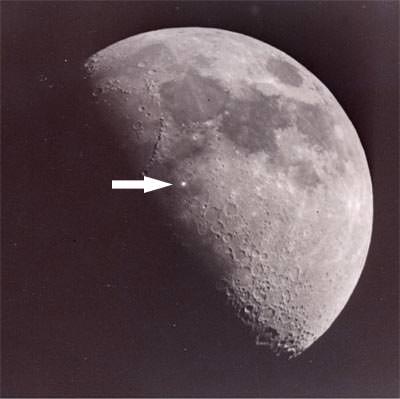[/caption]
For hundreds of years, people have seen tiny flashes of light on the surface of the Moon. Very brief, but bright enough to be seen from Earth, these odd flashes still hadn’t been adequately explained up until now. Also known as Transient Lunar Phenomena (TLPs), they’ve been observed on many occasions, but rarely photographed. On Earth, meteorites burning up in the atmosphere can produce similar flashes, but the Moon has no atmosphere for anything to burn up in, so what could be causing them? As it turns out, according to a new study, the answer is still meteorites, but for a slightly different reason.
The lights don’t result from burning up as on Earth, but rather are hot blobs of material produced by the impact itself. The impacts were calculated to be powerful enough to melt the meteorites, producing super hot liquid droplets, called melt droplets, that produced light as they formed and then began to cool afterwards. The meteorites themselves can be tiny, but still cause an impact that could be seen from Earth.
Sylvain Bouley, a planetary scientist at the Paris Observatory and co-author of the study, explains: “You have just a small piece of cometary material or asteroid, about 10 centimeters, that can do a very bright flash visible from the Earth.”
Fellow planetary scientist Carolyn Ernst of Johns Hopkins University’s Applied Physics Laboratory, adds: “Something is melting, and because it’s so hot, it radiates in the visible wavelength until it cools down.”
The study included observations from 1999 – 2007, for which the brightness of the flashes and sizes and speeds of the meteorites were calculated.
The impacts have also been replicated at the Meteoroid Environment Office at the Marshall Space Flight Center, where tiny aluminum spheres were shot into simulated lunar dirt. The results were similar, helping to confirm the other team’s findings.
Other previous possible explanations included reflections on the Moon by tumbling satellites or even volcanic activity. There may still be debate though, as an earlier report in 2007 had attributed the flashes to outgassing on the Moon’s surface.
The paper will be published in the March 2012 issue of Icarus.


Sounds like a job for the Mythbusters.
Hot diggity dirt!
Given the number of meteors that hit Earth every day, it’s logical to assume that these flashes are impact events.
great article, paul! wouldn’t you love to catch one of these while observing? of course, unless you were videoing the moon at the time, you might not want to believe your own eyes. ah, my… no wonder some of us get into LTP work! thanks for reminding readers that there are many reasons to observe the moon!
Thanks, Tammy. Yeah I would, I’ve never seen one yet. I need to get a new telescope though too… 🙂
Wikipaedia has a good article…
http://en.wikipedia.org/wiki/Transient_lunar_phenomenon
I particularly like the Canterbury Monk’s description.